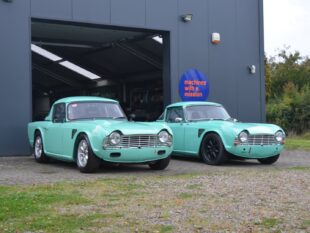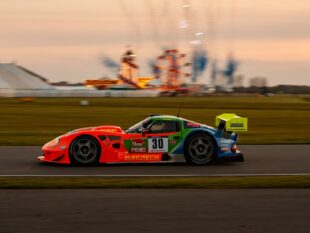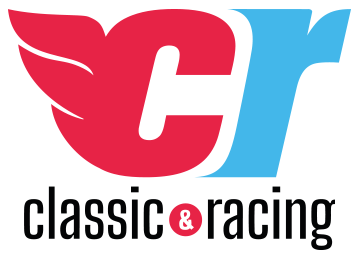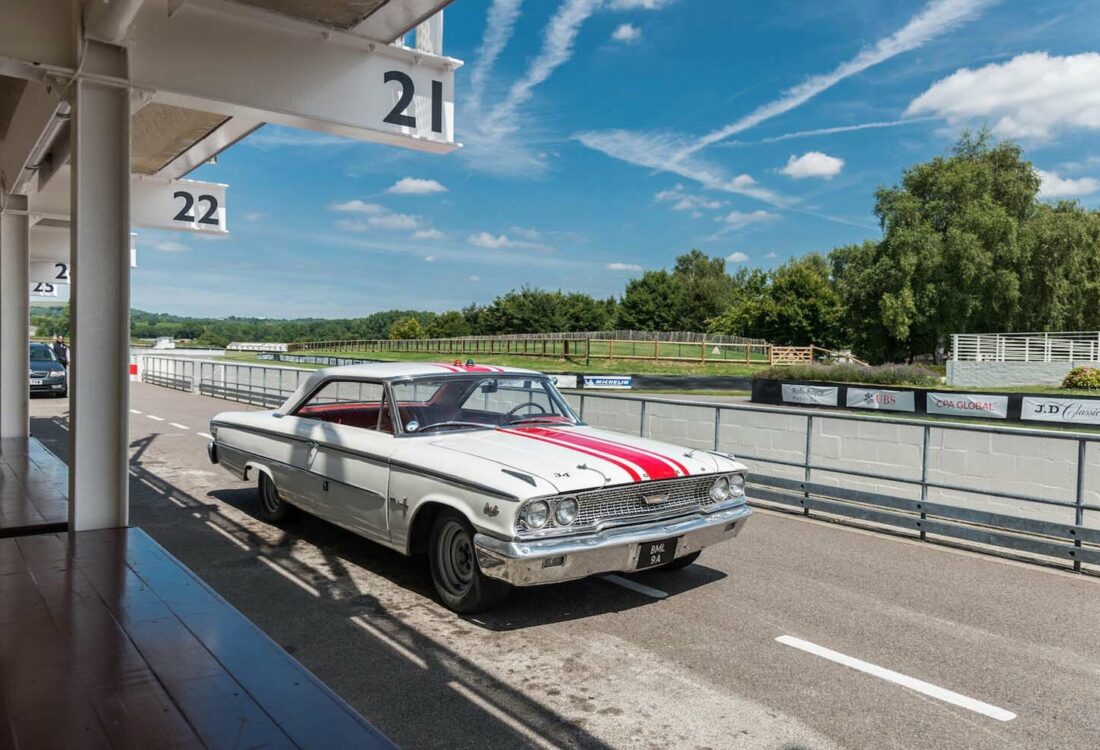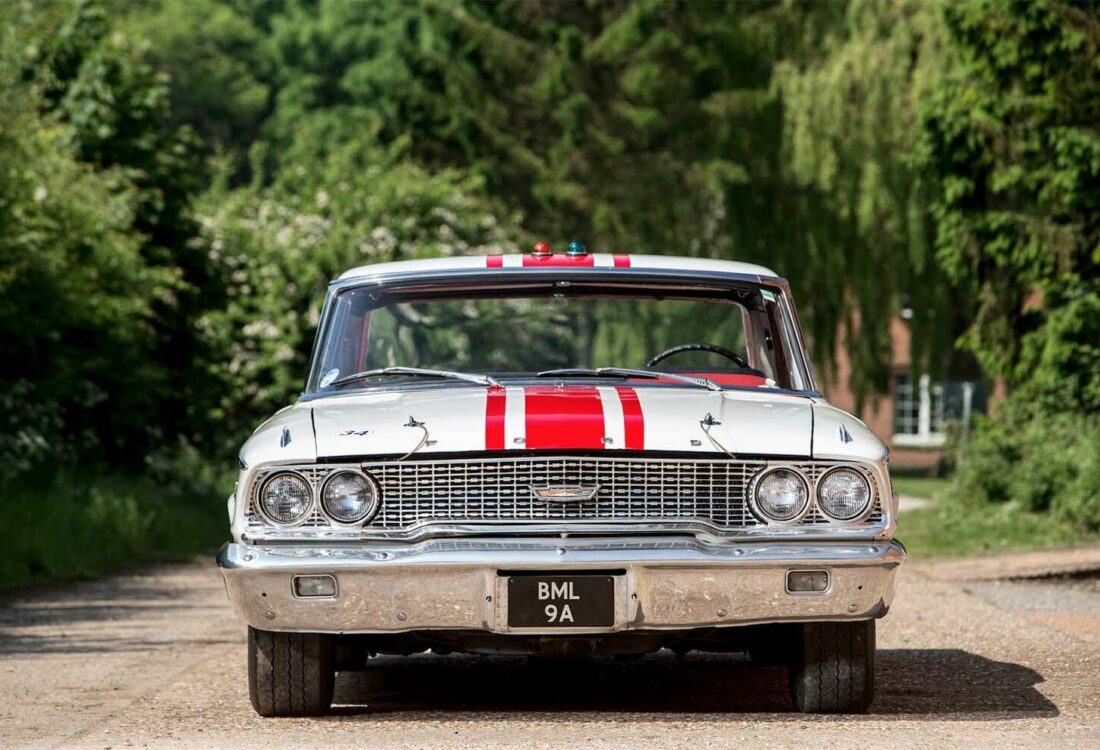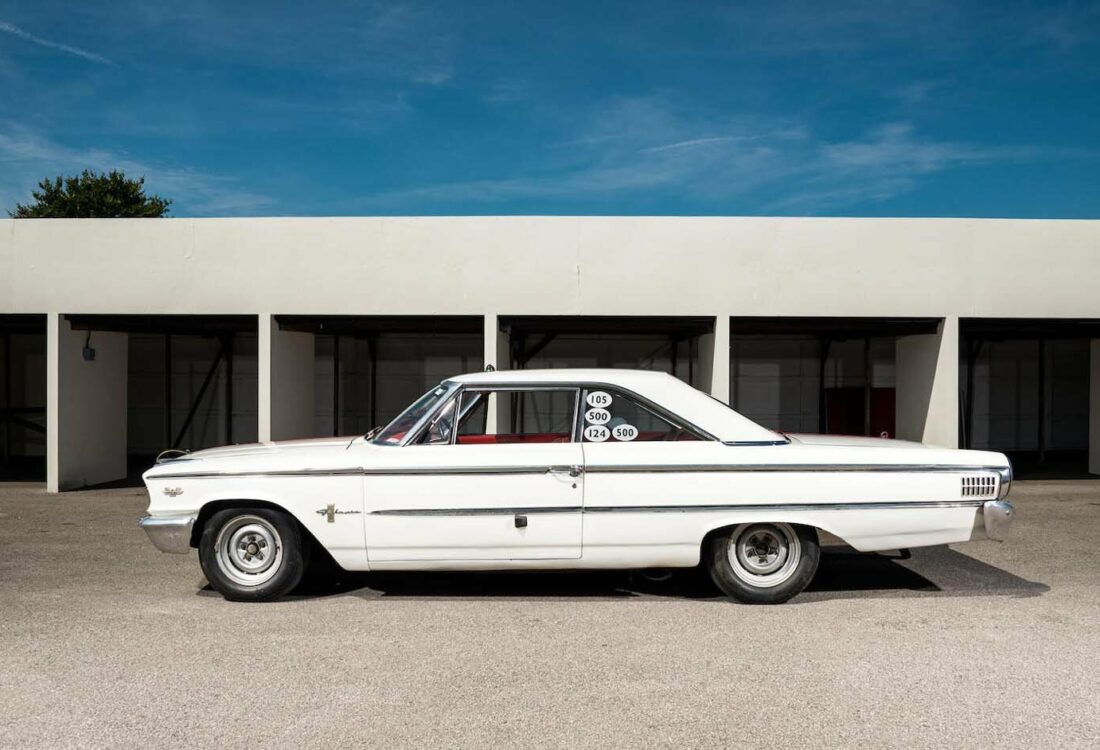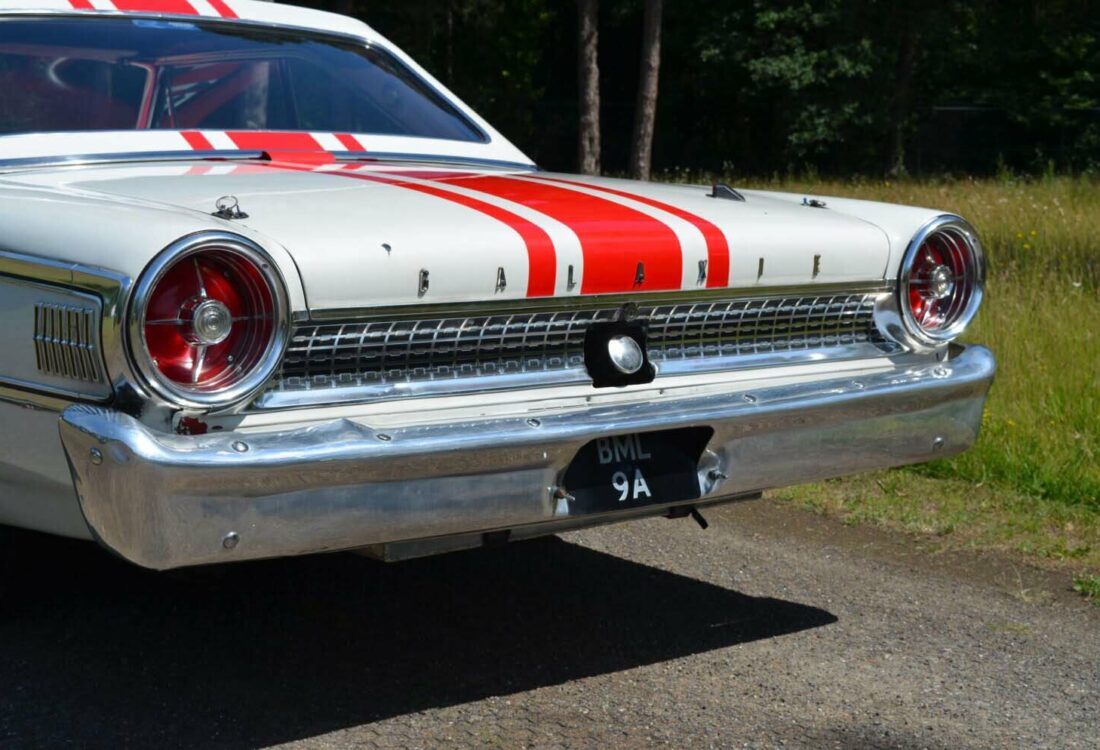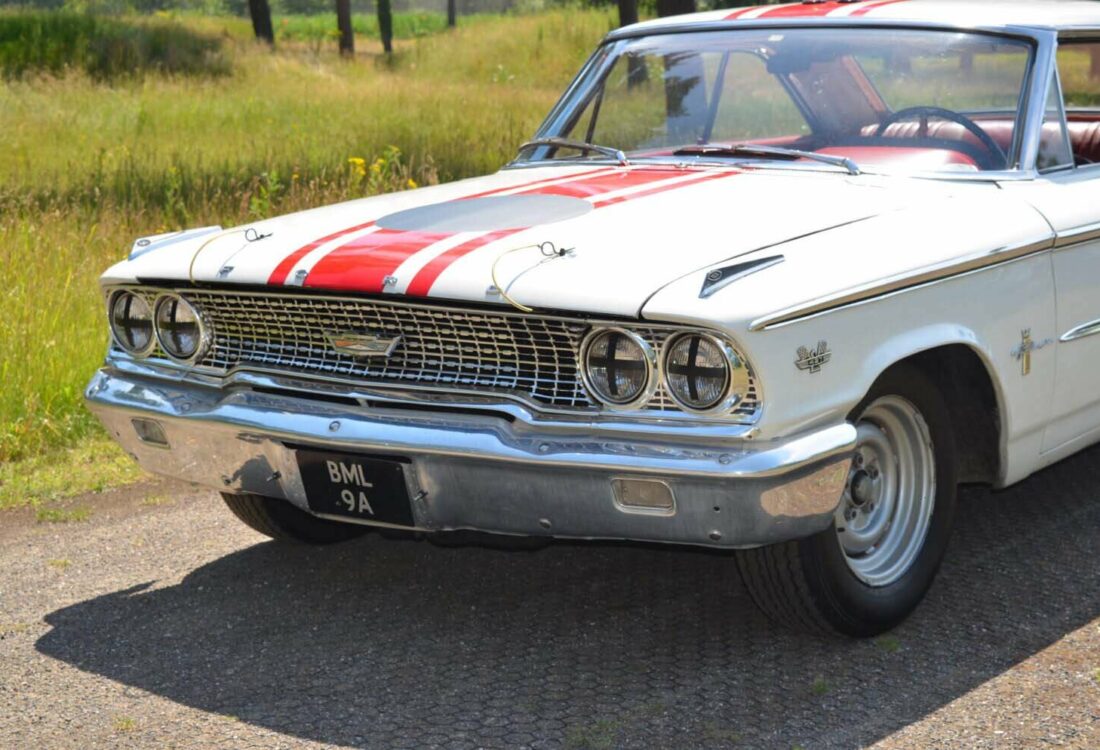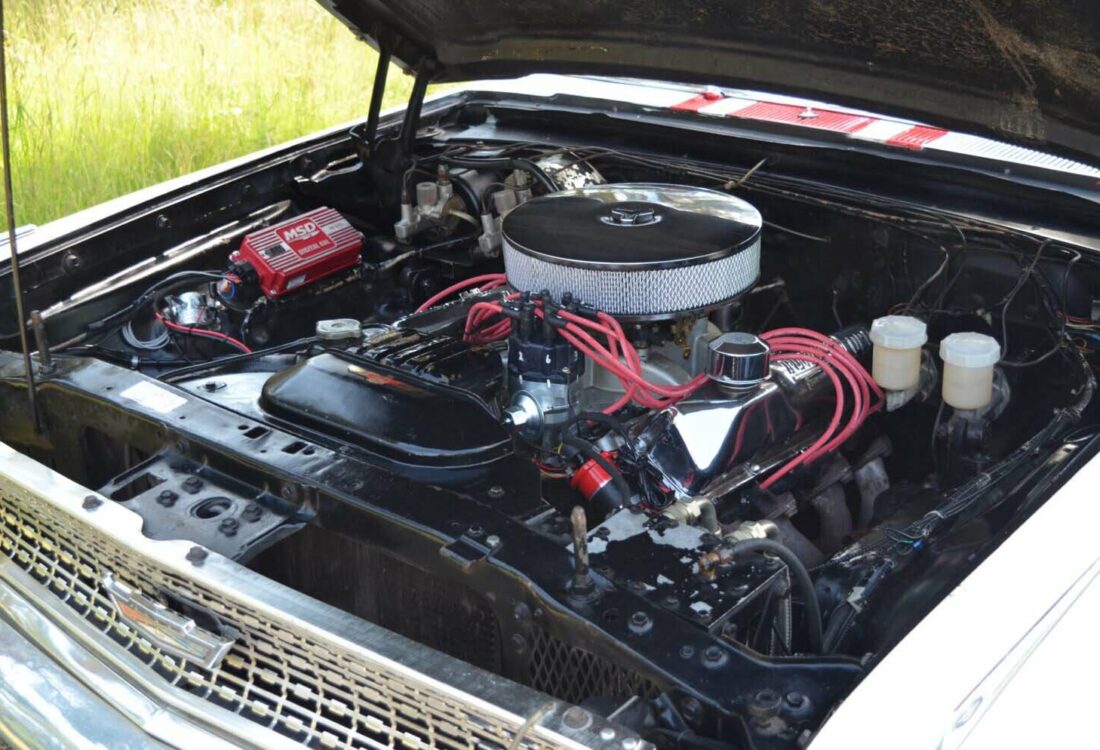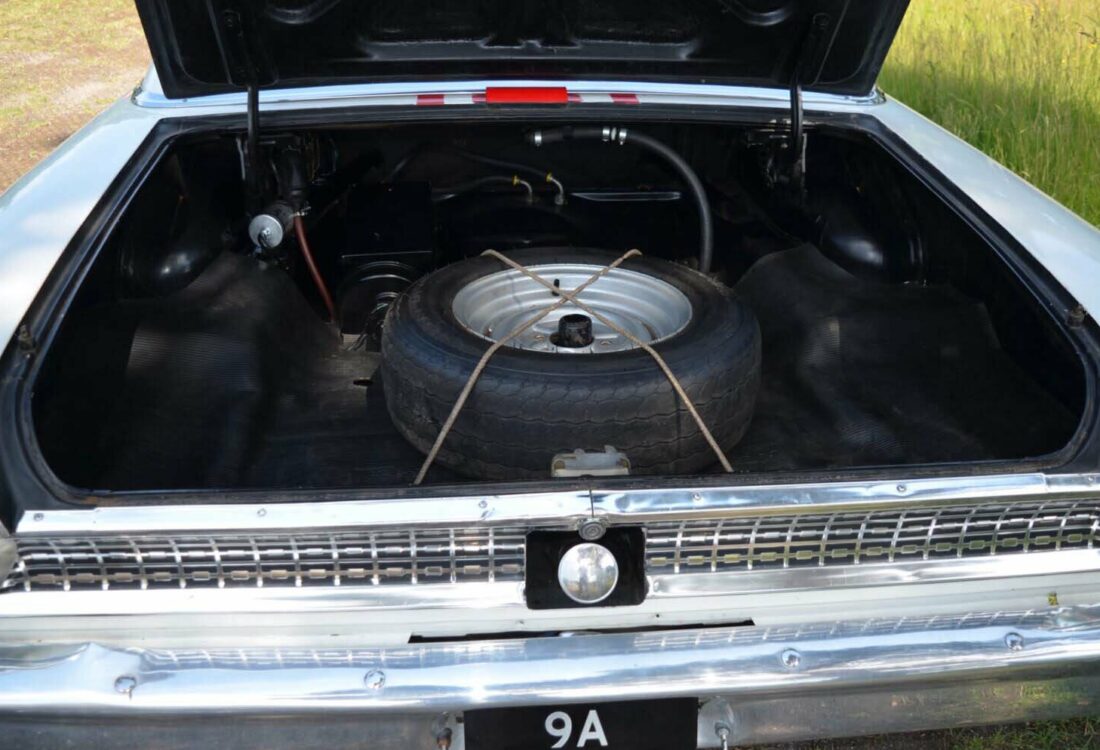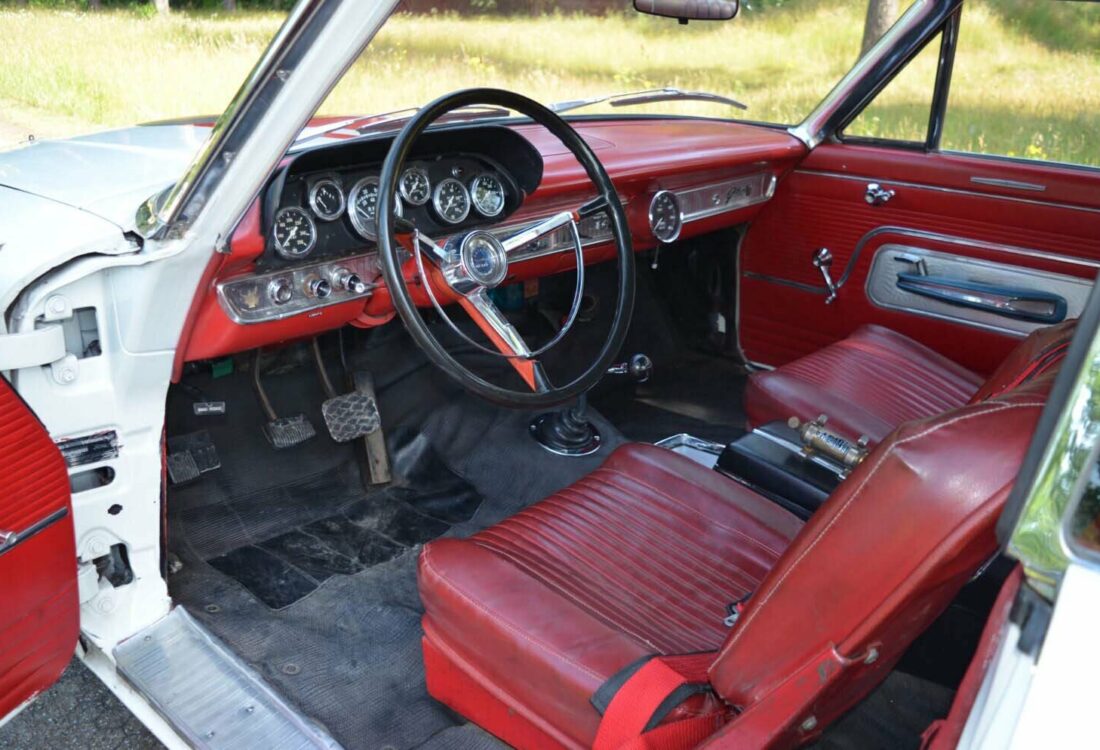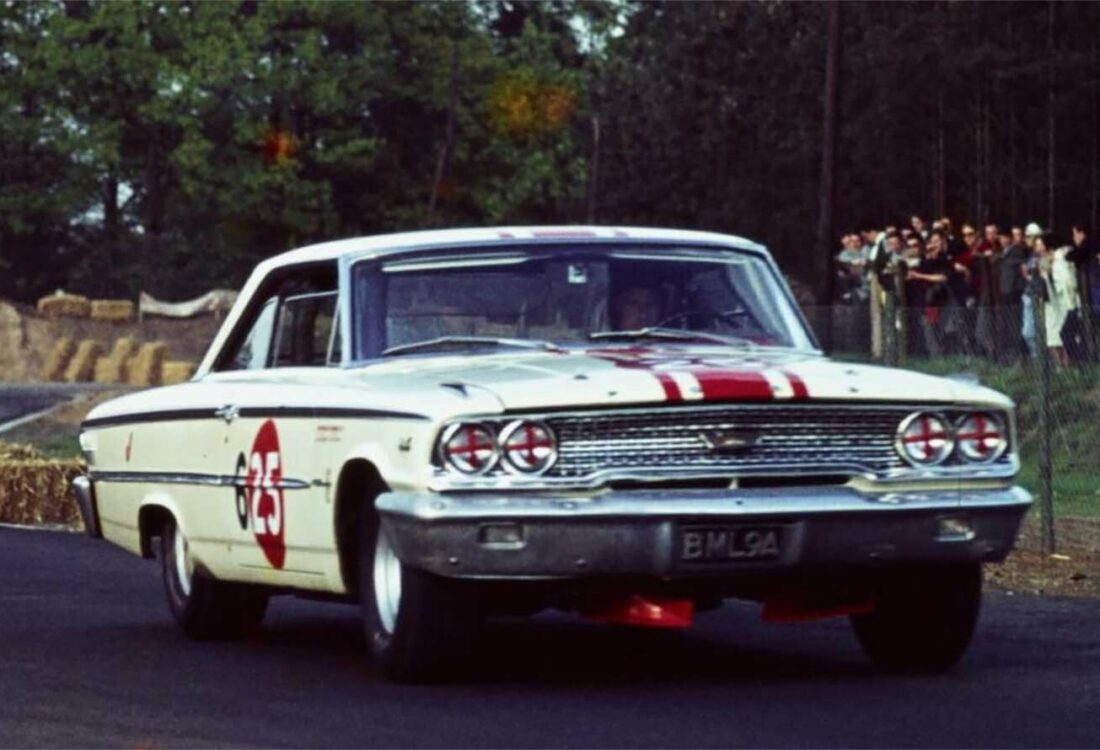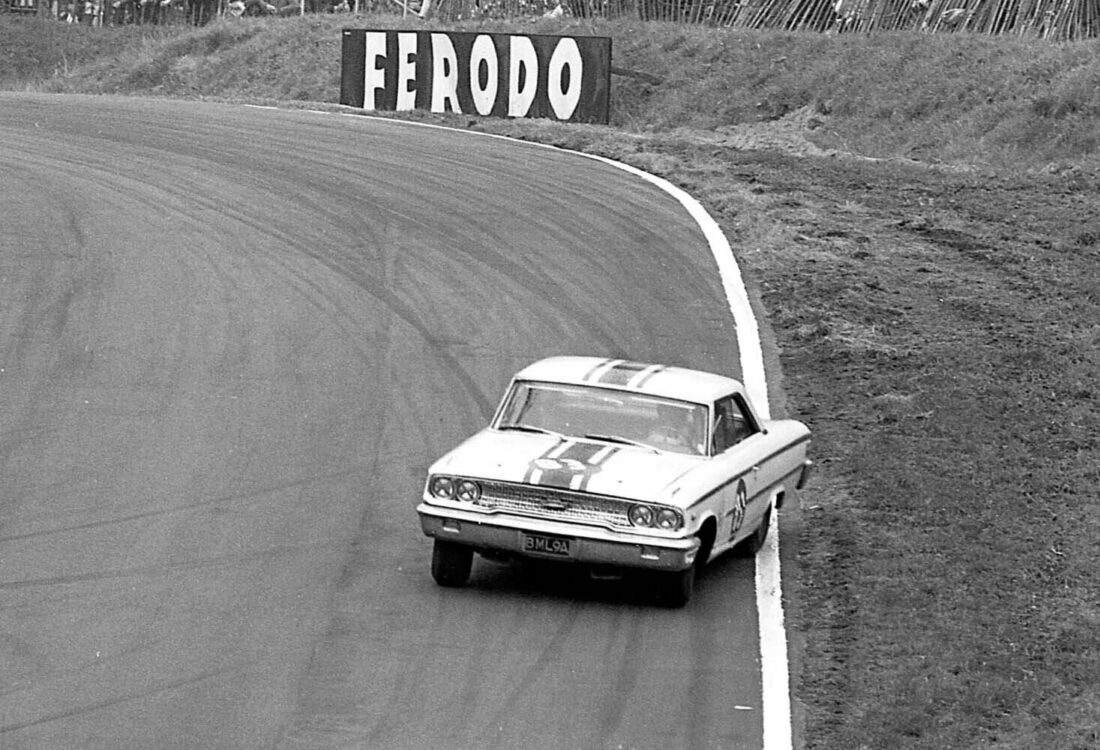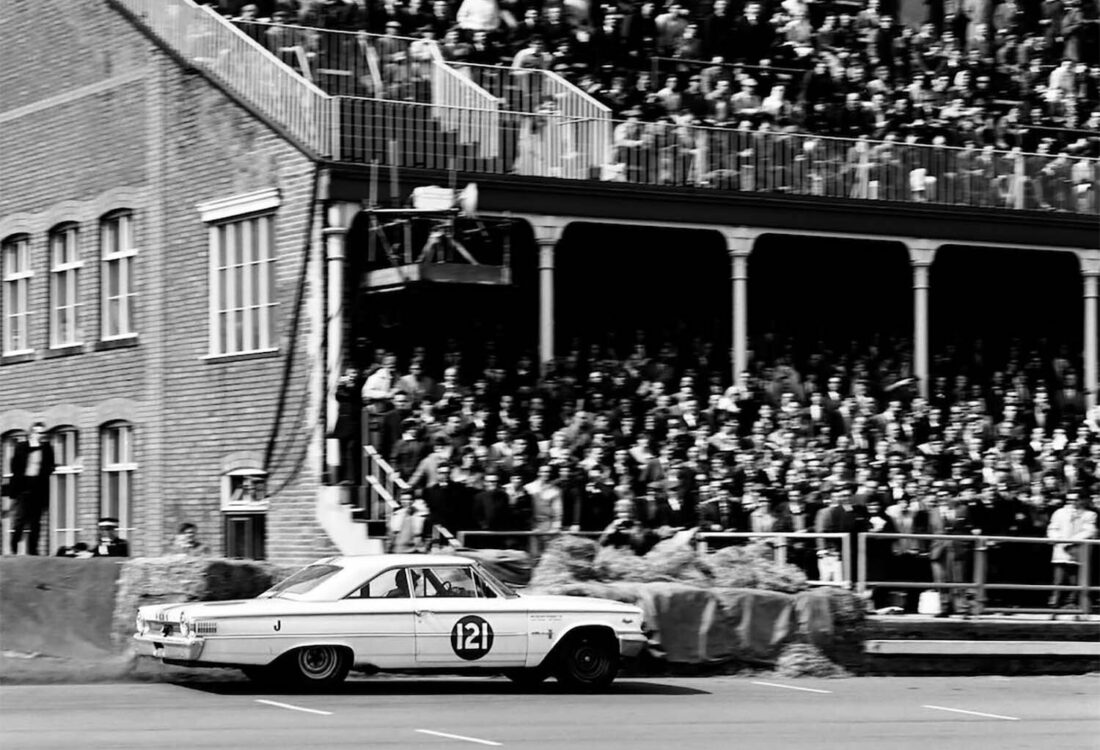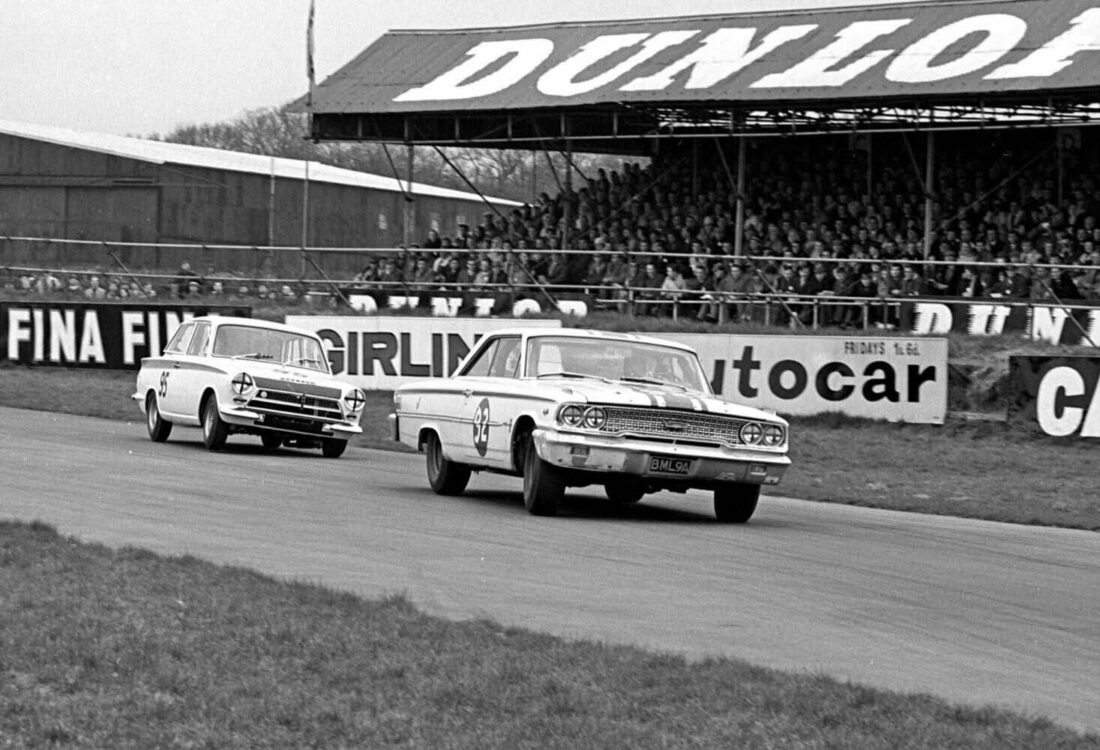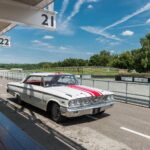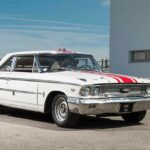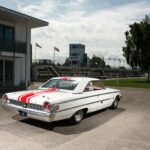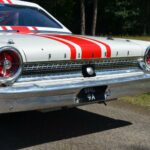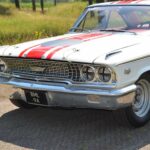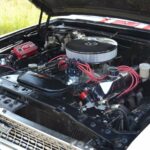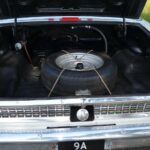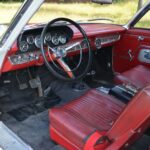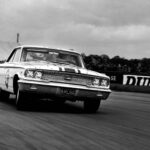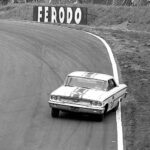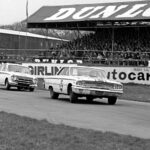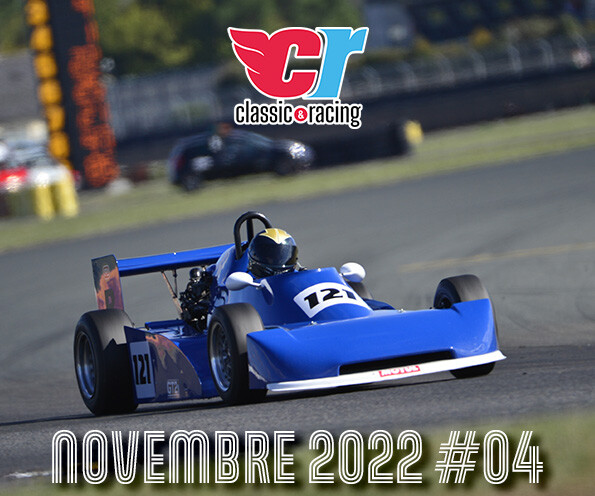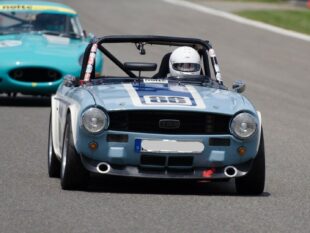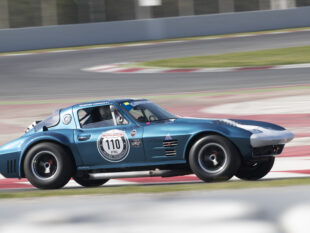
FORD GALAXIE R-CODE [Vendu]
Les services + de Classic Racing
Bientôt disponible

Bientôt disponible
A votre service depuis 1995, Transfret c’est avant tout le respect des collaborateurs et des clients.
Pour transporter de 1 à 6 voitures partout en Europe, contactez nous sur www.groupe-transfret.com
La voiture originale de l’équipe de course Ex-Willment, châssis 3N66R143030, immatriculation britannique BML 9A. Cette auto légendaire a remporté le British Saloon Championship et fut pilotée par Jack Sears, Graham Hill, Frank Gardner, Paul Hawkins & Bob Olthoff.
Documentation historique complète avec images de course d’époque, avis, factures et correspondance Ford / FIA originale.
Ford, la Galaxie et la concurrence.
Ford est synonyme de succès en compétition, ayant remporté pas moins de treize championnats pilotes en Formule 1, dix championnats constructeurs en Formule 1, seize championnats des constructeurs NASCAR, quatre championnats du monde des constructeurs des rallyes et remporté trois victoires absolues aux 24 Heures du Mans. Ainsi, lorsque la Ford Galaxie a fait ses débuts dans le championnat britannique des berlines en 1963, la concurrence était inquiète, et à juste titre.
Ford a présenté la Galaxie 1963 ½, également connue sous le nom « R-Code », avec une ligne de toit fastback plus basse et un nouveau moteur V8 d’usine à double carburateur et gros bloc de 427 ci, produisant 425 ch. Cependant, cela n’était toujours pas assez performant pour certains, Ford ayant commandé environ 210 éditions «légères» du «R-Code» 427, uniquement disponibles en blanc corinthien avec un intérieur en vinyle rouge. Ces Galaxie «légères» ont été spécifiées avec une boîte de vitesses Borg-Warner T10 à quatre vitesses, un rapport de pont arrière de 4,11:1 et une suspension renforcée. Pour gagner du poids, les panneaux de carrosserie en acier ont été remplacés par un capot, un coffre et des ailes avant en fibre de verre, ainsi que des pare-chocs en aluminium. La roue de secours et les outils ont été retirés ainsi que tout matériau insonorisant et la plupart des garnitures intérieures. Au total, ces « lightweight » très spéciaux pesaient 170 kg de moins !
Avec la concurrence à l’esprit, Ford avait expédié plusieurs lightweight Fastback ‘R-Code’ à Holman & Moody en Caroline du Nord, aux États-Unis. L’équipe Holman & Moody a eu un effet durable sur le sport automobile, avec ses innovations, notamment les réservoirs, les systèmes d’incendie embarqués et les freins à disque à changement rapide.
Pour faire de ces lightweight l’envie de tous les concurrents, Holman-Moody a fait appel à leur vaste expérience NASCAR pour créer la voiture qui allait changer le visage du British Saloon Car Championship. Les lightweight étaient équipés de points de transmission renforcés, de soudures de châssis et d’un arceau de protection plus rigide. Les triangles de suspension étaient également plus solides avec des amortisseurs doubles. Holman-Moody avait également développé sa propre version améliorée du tristement célèbre moteur V8 427 ci, avec un collecteur d’admission de taille moyenne et des primaires d’échappement en Y fabriqués par Belanger Brothers alimentant des tuyaux de sortie latéraux ovales qui traversaient les rails du châssis. Pour le British Saloon Car Championship, Holman & Moody a conçu et construit seulement trois voitures selon cette spécification. La vente comprend une copie de la correspondance entre Ford, Holman-Moody et la FIA sur l’homologation réussie pour les courses internationales en Europe ainsi que les feuilles de construction d’époque.
Cette Ford Galaxie 500 ‘R-Code’ légère construite par Holman-Moody en 1963
À la fin de 1962, la Ford Motor Company of America étendait considérablement ses activités de course et demanda à John Willment Automobiles de piloter l’une de leurs Galaxies en Grande-Bretagne. Ainsi, en janvier 1963, le pilote de course britannique, Jack Sears, reçoit un appel téléphonique de Jeff Uren, Team Manager de John Willment Automobiles. Jeff a expliqué que l’équipe nouvellement formée de Twickenham achetait un “full-house Holman & Moody NASCAR Ford Galaxie » avec laquelle ils comptaient affronter Jaguar dans le British Saloon Car Championship. Oh, et ils voulaient que Jack la conduise !
Jack Sears était un vétéran des courses de berlines, ayant remporté le premier championnat britannique de berlines en 1958. Sears a également remporté une victoire de classe aux 24 Heures du Mans 1963 avec Mike Salmon à bord d’une Ferrari 330 LMB engagée par Maranello Concessionaires. Une autre victoire de classe a suivi aux 24 Heures de Daytona en 1965, au volant de l’un des coupés Daytona pour John Willment, et des records folkloriques selon lesquels il a dépassé 180 mph sur la nouvelle autoroute M1 en Angleterre lors du test d’un Cobra avant les 1964 Le Mans 24 Heures!
Cette voiture, châssis no. 3N66R143030 était l’un des rares poids légers Galaxie 500 expédiés à Holman & Moody pour les améliorations de la compétition et était l’une des trois seules destinées au British Saloon Car Championship. Une fois terminé en Caroline du Nord, ce Galaxie a parcouru plus de 600 miles jusqu’à New York, garantissant qu’il serait livré par avion à temps pour la grande réunion internationale du BRDC en mai à Silverstone. Ce Galaxie a été embarqué à bord d’un avion de l’USA Airforce Transport, assis à côté d’une livraison de Coca Cola pour les bases aériennes américaines en Angleterre ! Étonnamment, cette Galaxie est accompagnée de sa facture de vente originale de Holman-Moody à « John Willment Automobiles Ltd, 161 Chertsey Road, Twickenham, Middlesex, Angleterre » avec le prix de vente enregistré à 3 342,98 $.
La cinquième manche du British Saloon Car Championship de 1963 a eu lieu à Silverstone, lors de la 15e réunion internationale du trophée. Comme Jack l’a rappelé “Sans essayer terriblement dur, je me suis ensuite qualifié en pole position, plus vite que toutes les Jaguars.” Le jour de la course est arrivé et alors que Kenneth Evans a laissé tomber le drapeau, Sears a pris un départ calculé, étant battu au premier virage par trois Jaguars avec Graham Hill suivi de Roy Salvadori et Gawaine Baillie. Sears se souvient dans sa biographie “Gentleman Jack” “Lors de cette première course, j’avais des freins à tambour avec des garnitures métal sur métal, donc ils ne se sont pas décolorés et étaient en fait assez bons, mieux que vous ne le pensez. J’ai trouvé que les Jaguars ne me freinaient pas, alors quand nous avons quitté Chapel Corner et sommes arrivés sur Hanger Straight, j’ai senti, mon Dieu, cette chose vole vraiment, je pense que je peux les dépasser. À ma grande surprise, j’ai dépassé les trois Jaguar en une seule manœuvre. Je n’avais pas le temps de faire signe de la main ou quoi que ce soit du genre ; J’avais la tête baissée pour me concentrer, mais c’était maintenant le moment de vérité lorsque j’ai atteint mon point de freinage pour Stower. À ma grande surprise, ils ne sont pas passés devant moi mais m’ont juste suivi. J’ai posé mon pied dans la sortie de l’Abbaye en montée rapide à gauche et la Galaxie vient de s’éloigner des Jaguars. À la fin du deuxième tour, j’avais une avance confortable même si j’étais toujours inquiet pour l’embrayage, alors j’ai laissé la Galaxie en quatrième vitesse pour le reste de la course – je n’ai plus jamais changé de vitesse… »
À mi-distance, Sears avait accumulé une avance de plus de 20 secondes sur Roy Salvadori, et après avoir établi un nouveau record du tour de Saloon Car pour Silverstone, a reçu le signal d’assouplissement de Jeff Uren pour remporter la première victoire non-Jaguar dans le Championnat britannique des berlines 1963 !
Deux semaines plus tard, Jack Sears et le Willment Galaxie sont revenus sur la piste, cette fois pour la course de 100 milles autour du parcours complet du Grand Prix à Aintree. Jack était à nouveau intouchable, mais n’a pas étiré le gros Galaxie, à la place, en faisant juste assez pour franchir la ligne devant le peloton.
Deux courses après le début de sa carrière européenne, et la Galaxie avait remporté deux victoires avec Jack Sears, mais la course du British Saloon Car Championship à Crystal Palace offrait un nouveau défi le 3 juin 1963. Finies les courbes fluides d’Aintree et l’étendue ouverte de Silverstone, Aintree était serré, sinueux et précis. Vous auriez misé sur les Ford Cortina de moins de 2 litres, les petites Mini ou les Jaguar plutôt que sur la Galaxie qui, selon les mots de Sir John Whitmore, « avait l’air aussi grosse qu’un porte-avions ! Les pilotes Jaguar ont essayé tout ce qu’ils savaient, mais Sears et ses sept litres de V8 Galaxie étaient absolument intouchables. A la fin de la course, c’est à nouveau Jack Sears qui s’est vu remettre la guirlande des vainqueurs.
Quelques semaines plus tard, le Galaxie et Sears ont participé à la réunion du trophée commémoratif Archie-Scott Brown à Snetterton. La première course de la journée était pour les berlines avec des modifications illimitées et était une autre victoire pour Jack et la Galaxie. Cependant, une victoire en course n’a pas suffi à Sears à Snetterton, et lui et le Galaxie ont également participé à la dernière course de la journée pour les berlines du groupe 2. Comme cela devenait presque une tradition, le grand Galaxie s’est échappé du peloton pour remporter sa deuxième victoire en une journée !
Fin juillet, Silverstone a accueilli le British Grand Prix Meeting, avec Sears et cette Galaxie en compétition dans la Saloon Car Race, septième manche du British Saloon Car Championship de 1963. La domination du Galaxie était telle sur le grand circuit spacieux du Grand Prix de Silverstone, que Sears a remporté une autre victoire, plus d’une minute devant le premier non-Galaxie ! Il s’agissait de la sixième victoire consécutive de la Galaxie et de la troisième victoire consécutive de la British Saloon Car, plaçant fermement Sears et la Galaxie dans la course au championnat.
Brands Hatch a organisé la sixième manche du British Saloon Car Championship le 5 août, avec Sears à nouveau en compétition dans cette formidable Ford Galaxie. Cette course de 20 tours a vu Jim Clark piloter la Ford Galaxie d’Alan Brown Racing, donnant à Sears une nouvelle compétition. Malheureusement, la bataille entre Sears et Clark pour la tête de la course s’est terminée au neuvième tour lorsque Sears a rampé dans les stands avec une défaillance du pneu arrière gauche.
Quelques semaines plus tard, la Galaxie revient à Brands Hatch, cette fois pilotée par le pilote sud-africain Bob Olthoff. Après avoir fait ses débuts en compétition à la fin des années 1950 en Afrique du Sud, Olthoff a progressé pour courir en Amérique et en Europe, participant aux 24 Heures du Mans, aux 12 Heures de Sebring et aux 1000 km du Nurburgring.
Lors de sa première épreuve aux commandes de la grande Galaxie, Olthoff s’est qualifié avec une impressionnante deuxième place, n’étant devancé que par Roy Salvarodi dans la Alan Brown Ford Galaxie. Alors que le drapeau tombait, Olthoff a pris un excellent départ, mais la Jaguar de Mike Salmon s’est tout de même glissée en tête, mais seulement brièvement jusqu’à ce que le grand Galaxie prenne la tête le long de la ligne droite supérieure, une position qu’il conserverait jusqu’au drapeau à damier, 31 tours. plus tard!
La prochaine course pour le Galaxie était la réunion de la Gold Cup d’Oulton Park à la fin septembre. Pour cet événement, Willment a remis la Galaxie au champion du monde de Formule 1 en titre, Graham Hill. Dan Gurney est parti en pole position dans une autre Ford Galaxie, mais Hill a rapidement retrouvé ses marques et s’est aligné deuxième sur la grille. Hill a franchi la ligne d’arrivée deuxième dans ce Galaxie, avec Sears 30 secondes plus loin en troisième position. Peut-être que Sears aurait dû rester avec sa fidèle Galaxie à Oulton Park après tout !
Une semaine plus tard, Sears reprenait le volant de la Galaxie, cette fois pour l’Autosport Three Hour Meeting Saloon Car Race à Snetterton. Sears a de nouveau qualifié la Galaxie en pole position, battant en fait son propre record du tour de cinq secondes monumentales, et même plus vite que l’Aston Martin DB4 GT Zagato réalisé dans la course principale de trois heures !
Pour la Saloon Car Race, Jeff Uren a décidé de confier la grosse Ford à Bob Olthoff, qui a essayé la voiture lors des qualifications, établissant un temps à peine 0,8 seconde plus lent que Sears. Olthoff a bien commencé, menant le champion du monde de Formule 1, Jack Brabham dans une sœur Galaxie, jusqu’à ce que des problèmes de transmission l’obligent à prendre sa retraite à Sear Corner.
La réunion de Snetterton a marqué la fin du B.R.S.C.C. British Saloon Car Championship et Jack Sears a été couronné champion, après avoir remporté la victoire dans chaque course qu’il a terminée dans ce Holman & Fabriquée par Moody, préparée par John Willment Racing, Ford Galaxie 500 ‘R-Code’ Lightweight.
Alors que la saison de course européenne tire à sa fin, l’équipe Willment, Jack Sears et cette Galaxie se sont rendus en Afrique du Sud pour continuer à courir. La Galaxie a été envoyée en Afrique du Sud avec un carnet du Royal Automobile Club, avec sa première course début novembre, la Rand Daily Mail 9 Hour Endurance Race à Kyalami, mieux connue sous le nom de Kyalami 9 Hours.
La course d’endurance de neuf heures nécessitait deux pilotes, alors Willment a demandé au coureur australien, Paul Hawkins, de partager les responsabilités de conduite avec le nouveau champion couronné, Jack Sears. La course a commencé avec 40 000 spectateurs témoins d’une escapade à la Mans, et le grand Galaxie s’est rapidement imposé dans le top trois. Cependant, le plus impressionnant, c’est que la Galaxie était en tête de l’indice de performance, battant même la Ferrari 250 GTO en tête de la course. Malheureusement, juste au moment où le crépuscule est tombé, le grand Galaxie devait abandonner avec un joint de culasse défectueux alors qu’il était troisième au général, toujours en tête de l’indice de performance.
La dernière sortie du Galaxie dans sa première année de compétition a été la réunion du Grand Prix d’Afrique du Sud à East London le 28 décembre. Pilotée une fois de plus par Paul Hawkins, cette Galaxie franchit la ligne d’arrivée en deuxième position au classement général, seulement battue par la soeur Willment Automobiles Ford Cortina, pilotée par Bob Olthoff. Pour conclure sa première tournée en Afrique du Sud, cette Galaxie a été engagée dans la Touring Car Race à Killarey au Cap, avec Hawkins à nouveau au volant, terminant deuxième de la manche et troisième au classement général de la finale.
Après la course de Killarney, l’équipe Willment est retournée en Angleterre avec ses voitures pour se préparer au championnat britannique de berlines de 1964. Jack Sears avait choisi de défendre au mieux son titre de 1963, en pilotant ce même Galaxie dominant pour la saison 1964.
La première manche du British Saloon Car Championship de 1964 a eu lieu à Snetterton à la mi-mars, où Jack Sears a abandonné avec des dommages aux roues. Le deuxième tour a vu Sears et ce Galaxie revenir sur leur chemin gagnant, remportant la victoire pure et simple au Goodwood St Mary’s Trophy le 30 mars. Sears a de nouveau dominé le peloton, établissant un nouveau record du tour de classe – le tour le plus rapide jamais réalisé à Goodwood par une berline!
Oulton Park a accueilli la troisième manche du championnat, Sears pilotant à nouveau sa monture préférée. S’étant rapidement affirmé en tête, tout allait à nouveau comme prévu, jusqu’à ce que Sears tente de freiner pour le virage de Lodge au cinquième tour et constate que les freins étaient tombés en panne. Heureusement, il a délibérément fait tourner la voiture pour éviter de heurter la berge et de causer des dommages.
Une semaine plus tard et Sears corrigeait les torts d’Oulton Park, se qualifiant à nouveau en pole position, deux secondes incroyables plus vite que Jim Clark ! Comme l’a rapporté Patrick McNally pour Autosport “L’épreuve de la berline a été remportée par Jack Sears dans la Willmont Ford Galaxie après sa conduite fulgurante habituelle – il a également battu le record de la berline de plus de 3 litres (et pur et simple), le ramenant à 2 minutes 11,4 secondes .”
La prochaine étape était la National Saloon Car Race à Silverstone, dominée à nouveau par les grands Galaxie et Sears, avant de revenir sur la même piste pour la prochaine manche du British Saloon Car Championship le week-end suivant, poursuivant la séquence ininterrompue de victoires des Galaxies au Silverstone. circuit.
Sears ne s’est pas contenté de concourir et de gagner contre le peloton anglais, et en mai a emmené la Galaxie et John Willment Automobiles sur le circuit belge de Zolder, pour la manche d’ouverture du Championnat d’Europe des voitures de tourisme 1964. Après s’être qualifié en pole position, Sears a pris un excellent départ et a dominé la course, se voyant remettre la guirlande des gagnants par Miss Belgique et Miss Beauté – une journée difficile pour Sears !
Le temps de course de Sears avec le Galaxie touchait à sa fin, avec quatre courses à faire. Cependant, lors de ces quatre dernières courses à Aintree, Crystal Palace et Brands Hatch, le Galaxie et Sears ont remporté trois pole positions, trois tours les plus rapides et deux victoires en course !
Maintenant que la saison européenne était terminée, John Willment Automobiles s’est à nouveau dirigé vers l’Afrique du Sud pour la série Springbok. Cette année, l’équipe Willment a choisi d’inverser sa palette de couleurs pour la tournée sud-africaine. Auparavant, l’équipe pilotait des voitures blanches avec des bandes rouges sur toute la longueur de la voiture au centre, mais pour l’Afrique du Sud, les voitures ont été repeintes en rouge, avec des bandes blanches sur toute leur longueur.
La série Springbok a été complétée par deux autres victoires de Hawkins, avant que Bob Olthoff ne pilote à nouveau lors de la réunion du Grand Prix d’Afrique du Sud de 1965, qui s’est tenue à East London. Après une énième course encourageante, Olthoff avait décidé que c’était la voiture avec laquelle il voulait concourir pour la saison 1965. Il a ensuite acheté la voiture à Willment Automobiles et a continué la domination de Galaxie, remportant de nombreuses courses tout au long de la série 1965 en Afrique du Sud, y compris des victoires à Kyalami, Roy Hesketh, Marlborogh et Killarney.
La dernière course d’Olthoff avec le grand V8 Galaxie était la Saloon Car Race du Grand Prix d’Afrique du Sud de 1966, où… vous l’avez deviné, le duo a remporté la victoire ! Une fin parfaite à la carrière de compétition de cette Ford Galaxie 500 Lightweight construite par Holman-Moody.
Bob Olthoff a continué à courir, mais cette Galaxie était plus qu’une simple voiture de course pour lui. Il l’a conservée dans sa collection et après avoir officiellement importé la voiture en Afrique du Sud, il a participé à la course de soutien historique du Grand Prix d’Afrique du Sud de 1974.
Alors que Jack Sears grandissait et se retirait de la course, il y avait une voiture dont il se souvenait plus affectueusement que d’autres, et c’était cette Galaxie, la voiture qui lui a apporté tant de succès, et en mai 1988, il a finalement réussi à convaincre Bob Olthoff de la vendre. à lui. Cette facture de vente accompagne toujours la voiture.
Toujours finie en rouge avec des rayures blanches, Sears a immédiatement renvoyé la voiture en Angleterre où elle a retrouvé son immatriculation routière d’époque “BML 9A”. Au début des années 1990, Sears entreprit de restaurer la voiture avec sympathie et contacta le directeur technique de l’équipe Willment, Mike Brown. Alors dirigeant son propre magasin, Rally Service Ltd à Middlesex, Brown entreprit de restaurer la voiture pour Sears avec des factures et des communications de ces travaux toujours contenues dans les impressionnants dossiers historiques accompagnant cette voiture. Le moteur a également été reconstruit par The Engine Shop of Maids Moreton, Buckingham, à cette époque.
Une fois les travaux sympathiques terminés, Sears était très fier d’utiliser régulièrement sa Galaxie sur la route et acceptait régulièrement la demande de Lord March de faire la démonstration de cette voiture d’importance historique lors des réunions du Goodwood Festival of Speed et de Goodwood Revival, le couple y assistant pas moins de six fois !
En 2008, Sears et ce Galaxie sont revenus sur les lieux de la réunion du trophée commémoratif Archie Scott-Brown de 1963, où le duo a remporté la victoire en deux courses, Snetterton. Des images de Jack avec la Galaxie dans les stands et sur le circuit sont contenues dans le dossier historique et montrent clairement à quel point cette voiture a procuré du plaisir à Jack. Cette Galaxie est restée la propriété de Jack Sears jusqu’à son décès en 2016.
De plus, cette voiture étant immatriculée au Royaume-Uni, le dossier historique contient également une quantité de certificats de contrôle technique britannique, montrant le kilométrage en augmentation constante, passant de 5 306 en juillet 1990 aux 7 800 affichés aujourd’hui.
C’était cette véritable Ford Galaxie 500 Lightweight, construite par Holman & Moody, préparée par John Willment Automobiles et conduite par Jack Sears qui a réécrit le British Saloon Car Championship. Une Jaguar n’était plus la seule voiture capable de dominer à partir du moment où cette Galaxie, avec son V8 de 7 litres de près de 500 ch, est arrivée sur les côtes britanniques, l’histoire des courses de berlines allait changer à jamais.
Jack Sears a remporté toutes les courses qu’il a terminées dans cette puissante Galaxie, remportant le championnat britannique de berlines de 1963, ajoutant à son titre de 1958 et ratant de peu le titre de 1965 à un certain Jim Clark. Bob Olthoff a remporté la victoire et le championnat sud-africain des voitures de tourisme en 1965 avec Paul Hawkins remportant également des victoires en course au volant. Le double champion du monde de Formule 1, Graham Hill, a également plongé cette Galaxie vers un podium lors de la réunion de la Gold Cup d’Oulton Park en 1964.
Le plus beau morceau d’histoire de cette voiture est peut-être que les deux pilotes qui ont remporté des championnats avec la voiture ont tous deux décidé de l’acheter, Sears en conservant la propriété jusqu’à son décès en 2016.
![]() For sale 1963 Ford Galaxie R-Code.
For sale 1963 Ford Galaxie R-Code.
The original Ex-Willment racing team car
Chassis 3N66R143030, UK registration BML 9A
Legendary British Saloon Championship winning Car
Driven by Jack Sears, Graham Hill, Frank Gardner, Paul Hawkins & Bob Olthoff
Full historic Documentation with period racing images, reviews, invoices and original Ford / FIA correspondence.
Ford, the Galaxie and competition
Ford is synonymous with competition success, having won no fewer than thirteen Formula One Drivers Championships, ten Formula One Manufacturers Championships, sixteen NASCAR Manufacturers Championships, Four World Rally Manufacturer Championships and claimed three outright victories at the Le Mans 24 Hours. So, when the Ford Galaxie made its debut in the 1963 British Saloon Car Championship, the opposition were worried, and rightly so.
Ford introduced the 1963 ½ Galaxie, also known as the ‘R-Code’ with a lower fastback roofline and new 427 ci big-block, dual-carburettor factory V8 engine, producing 425 bhp. However, this was still not enough performance for some, with Ford commissioning around 210 ‘Lightweight’ editions of the ‘R-Code’ 427, only available in Corinthian White with a red vinyl interior. These ‘Lightweight’ Galaxie’s were specified with a four-speed Borg-Warner T10 gearbox, 4.11:1 rear axle ratio and heavy-duty suspension. To save weight, steel body panels were exchanged for a fibreglass bonnet, boot and front wings along with aluminium bumpers, transmission cases and bell-housing. The spare wheel and tools were removed along with any sound deadening material and most of the interior trim. In total, these very special ‘Lightweight’s were a staggering 170 kg’s lighter!
With competition in mind, Ford had shipped several Fastback ‘R-Code’ Lightweights to Holman & Moody in North Carolina, USA. The Holman & Moody team had a lasting effect on motorsport, with their innovations including fuel cells, on-board fire systems and quick-change disc brakes.
To make these ‘Lightweight’s the envy of all competitors, Holman-Moody called upon their vast NASCAR experience to create the car that would change the face of the British Saloon Car Championship. The ‘Lightweight’s were fitted with strengthened pick up points, chassis welding and a stiffer roll cage. The suspension wishbones were also stronger with dual dampers. Holman-Moody had also developed their own enhanced version of the infamous 427 ci V8 engine, with medium-rise intake manifold and Belanger Brothers Y-piece fabricated exhaust primaries feeding to oval side exit pipes which crossed through the chassis rails. For the British Saloon Car Championship, Holman & Moody designed and built only three cars to this specification. Included in the sale is a copy of the correspondence between Ford, Holman-Moody and the FIA on the successful homologation for international races in Europe as well as the period build sheets.
This Holman-Moody built 1963 Ford Galaxie 500 ‘R-Code’ Lightweight
At the end of 1962, the Ford Motor Company of America was expanding its racing activities tremendously and asked John Willment Automobiles to race one of their Galaxies in Britain. So, in January 1963, British race driver, Jack Sears, received a telephone call from Jeff Uren, Team Manager of John Willment Automobiles. Jeff explained that the newly formed team from Twickenham were purchasing a “full-house Holman & Moody NASCAR Ford Galaxie” with which they intended to confront Jaguar in the British Saloon Car Championship. Oh, and they wanted Jack to drive it!
Jack Sears was a veteran of saloon car racing, having won the inaugural British Saloon Car Championship in 1958. Sears also claimed a class win at the 1963 Le Mans 24 Hours with Mike Salmon aboard a Maranello Concessionaires-entered Ferrari 330 LMB. Another class victory followed at the Daytona 24 Hours in 1965, driving one of the Daytona Coupes for John Willment, and folklore records that he topped 180 mph on the newly-opened M1 motorway in England when testing a Cobra ahead of the 1964 Le Mans 24 Hours!
This car, chassis no. 3N66R143030 was one of a select few Galaxie 500 Lightweights dispatched to Holman & Moody for competition enhancements and was one of only three destined for the British Saloon Car Championship. Upon completion in North Carolina, this Galaxie was driven over 600 miles to New York, ensuring it would be delivered by air in time for the major BRDC International May Meeting at Silverstone. This Galaxie was flown aboard a USA Airforce Transport plane, sitting alongside a delivery of Coca Cola for the USA air bases in England! Amazingly, accompanying this Galaxie is its original sales invoice from Holman-Moody to ‘John Willment Automobiles Ltd, 161 Chertsey Road, Twickenham, Middlesex, England’ with the sale price recorded as $3,342.98.
Round five of the 1963 British Saloon Car Championship was held at Silverstone, during the 15thInternational Trophy Meeting. As Jack recalled “Without trying terribly hard I then qualified on pole position, faster than all the Jaguars.” Race day came and as Kenneth Evans dropped the flag, Sears made a calculated start, being beaten to the first corner by three Jaguars with Graham Hill followed by Roy Salvadori and Gawaine Baillie. Sears recalls in his biography ‘Gentleman Jack’ “In that first race I had drum brakes with metal to metal linings so they didn’t fade and were actually quite good, better than you would believe. I found the Jaguars were not out-braking me, so when we left Chapel Corner and came onto Hanger Straight I felt, gosh, this thing is really flying, I think I can pass them. To my surprise I passed all three Jaguars in one manoeuvre. I had no time for waving or anything like that; I had my head down concentrating but now was the moment of truth as I hit my braking point for Stower. To my surprise they didn’t come past me but just followed me. I put my foot down in the exit from the fast-uphill left-hander Abbey and the Galaxie just pulled away from the Jaguars. By the end of the second lap I had a comfortable lead though was still worried about the clutch, so left the Galaxie in fourth gear for the rest of the race – I never changed gear again …”
At half distance, Sears had built up a lead of over 20 seconds from Roy Salvadori, and after setting a new Saloon Car lap record for Silverstone, was given the ease-up signal by Jeff Uren to claim the first non-Jaguar victory in the 1963 British Saloon Car Championship!
Two weeks later and Jack Sears and the Willment Galaxie returned to the track, this time for the 100-mile race around the full Grand Prix course at Aintree. Jack was again untouchable, but didn’t stretch the big Galaxie, instead, doing just enough to cross the line ahead of the field.
Two races into its European career, and the Galaxie had scored two victories with Jack Sears, but the British Saloon Car Championship race at Crystal Palace offered a new challenge on June 3rd 1963. Gone were the flowing curves of Aintree and open expanse of Silverstone, Aintree was tight, twisty and precise. You’d have put your money on the under 2-litre Ford Cortinas, the small Minis or the Jaguars rather than the Galaxie, which was, in the words of Sir John Whitmore, “looking as big as an aircraft carrier!” The Jaguar drivers tried all they knew, but Sears and his seven litres of V8 Galaxie were absolutely untouchable. At the end of the race, it was again Jack Sears who was presented with the race winners garland.
A few weeks later, the Galaxie and Sears entered the Archie-Scott Brown Memorial Trophy Meeting at Snetterton. The first race of the day was for the saloon cars with unlimited modifications and was another victory for Jack and the Galaxie. However, one race victory was not enough for Sears at Snetterton, and he and the Galaxie also entered the final race of the day for Group 2 saloons. As was becoming almost tradition, the big Galaxie romped away from the pack to claim its second victory in one day!
In late July, Silverstone hosted the British Grand Prix Meeting, with Sears and this Galaxie competing in the supporting Saloon Car Race, round seven of the 1963 British Saloon Car Championship. Such was the dominance of the Galaxie at the large spacious Silverstone Grand Prix circuit, that Sears claimed yet another victory, over a minute ahead of the first non-Galaxie! This marked the sixth consecutive victory for the Galaxie, and the third British Saloon Car victory in a row, firmly placing Sears and the Galaxie in the race for the championship.
Brands Hatch held round six of the British Saloon Car Championship on 5th August, with Sears again competing in this formidable Ford Galaxie. This 20-lap race saw Jim Clark pilot the Alan Brown Racing-entered Ford Galaxie, giving Sears some fresh competition. Sadly, the battle between Sears and Clark for the lead of the race ended on lap nine when Sears crawled into the pits with a left-rear tyre failure.
A few week later, the Galaxie returned to Brands Hatch, this time being driven by South African driver, Bob Olthoff. Having made his competition debut in the late 1950’s in South Africa, Olthoff progressed to race in America and Europe, competing in the Le Mans 24 Hours, Sebring 12 Hours and Nurburgring 1000 km.
In his debut event piloting the big Galaxie, Olthoff qualified an impressive second, only being bettered by Roy Salvarodi in the Alan Brown Ford Galaxie. As the flag dropped, Olthoff made a great start, but still the Jaguar of Mike Salmon squeezed into the lead, but only briefly until the big Galaxie powered into the lead along Top Straight, a position it would hold until the chequered flag, 31 laps later!
The next race for the Galaxie was the Oulton Park Gold Cup Meeting in late September. For this event, Willment handed the Galaxie to reigning Formula One World Champion, Graham Hill. Dan Gurney started on pole position in another Ford Galaxie, but Hill quickly found his feet and lined up second on the grid. Hill crossed the line second in this Galaxie, with Sears a further 30 second further back in third. Perhaps Sears should have stuck with his trusty Galaxie at Oulton Park after all!
One week later and Sears took back the wheel of the Galaxie, this time for the Autosport Three Hour Meeting Saloon Car Race at Snetterton. Sears qualified the Galaxie on pole position once again, actually beating his own lap record by a monumental five seconds, and even lapping faster than the Aston Martin DB4 GT Zagato’s achieved in the main three-hour race!
For the Saloon Car Race, Jeff Uren decided to hand the big Ford to Bob Olthoff, who trialled the car in qualifying, setting a time just 0.8 seconds slower than Sears. Olthoff started well, leading Formula One World Champion, Jack Brabham in a sister Galaxie, until transmission issues forced a retirement at Sear Corner.
The Snetterton meeting marked the end of the B.R.S.C.C. British Saloon Car Championship and Jack Sears was crowned Champion, having claimed victory in every race he finished in this Holman & Moody-built, John Willment Racing-prepared, Ford Galaxie 500 ‘R-Code’ Lightweight.
With the European racing season drawing to a close, the Willment Team, Jack Sears and this Galaxie headed to South Africa to continue racing. The Galaxie was sent to South Africa with a Royal Automobile Club Carnet, with its first race in early November, the Rand Daily Mail 9 Hour Endurance Race at Kyalami, better known as the Kyalami 9 Hours.
The nine-hour endurance race required two pilots, so Willment asked Australian racer, Paul Hawkins to share driving responsibilities with newly-crowned Champion, Jack Sears. The race started with 40,000 spectators witnessing a Le Mans-style getaway, and the big Galaxie quickly asserting itself well within the top three. However, most impressively the Galaxie was leading the Index of Performance, beating even the race-leading Ferrari 250 GTO. Unfortunately, just as dusk fell, the big Galaxie was to retire with a failed head gasket whilst running in third overall, still leading the Index of Performance.
The final outing for the Galaxie in its inaugural year of competition was the South African Grand Prix Meeting at East London on December 28th. Piloted by Paul Hawkins once more, this Galaxie crossed the finish line second overall, only beaten by the sister Willment Automobiles Ford Cortina, driven by Bob Olthoff. To conclude its first tour of South Africa, this Galaxie was entered in the Touring Car Race at Killarey in Cape Town, with Hawkins again driving, finishing second in the heat, and third overall in the final.
After the Killarney race, the Willment team returned to England with their cars to prepare for the 1964 British Saloon Car Championship. Jack Sears had chosen to defend his 1963 title in the best possible way, by driving this same dominant Galaxie for the 1964 season.
The first round of the 1964 British Saloon Car Championship was at Snetterton in mid March, where Jack Sears retired with wheel damage. Round two saw Sears and this Galaxie return to their winning ways, taking outright victory at the Goodwood St Mary’s Trophy on March 30th. Sears again dominated the pack, setting a new class lap record – the fastest lap to ever be done at Goodwood by a saloon car!
Oulton Park played host to round three of the Championship, with Sears again piloting his favoured steed. Having quickly asserted himself in the lead, all was once again going to plan, until Sears tried to brake for Lodge corner on the fifth lap and found the brakes to have failed. Fortunately he deliberately spun the car to avoid hitting the bank and causing any damage.
A week later and Sears corrected the wrongs of Oulton Park, again qualifying on pole position, an incredible two seconds faster than Jim Clark! As reported by Patrick McNally for Autosport “The saloon car evet was won by Jack Sears in the Willmont Ford Galaxie after his usual meteoric drive – he also broke the over 3-litre (and outright) saloon car record, dropping it to 2mins 11.4 seconds.”
Next up was the National Saloon Car Race at Silverstone, which again the big Galaxie and Sears dominated, before returning to the same track for the next round of the British Saloon Car Championship the following weekend, continuing the Galaxies unbroken streak of victories at the Silverstone circuit.
Sears was not content with competing, and winning against the English field, and in May took the Galaxie and John Willment Automobiles to Belgian racetrack of Zolder, for the opening round of the 1964 European Touring Car Championship. Having qualified on pole position, Sears got a great start and dominated the race, being presented with the winners garland by Miss Belgium and Miss Beauty – a tough day for Sears!
Sears’ time racing with the Galaxie was nearing its end, with four races left. However, from those last four races at Aintree, Crystal Palace and Brands Hatch, the Galaxie and Sears claimed three pole positions, three fastest laps and two race victories!
Now the European season was complete, John Willment Automobiles once again headed to South Africa for the Springbok series. This year the Willment team chose to reverse their colour scheme for the South African tour. Previously, the team raced white cars with red stripes running the length of the car in the centre, but for South Africa the cars were repainted red, with white stripes running their length.
The Springbok series was rounded out with two more victories by Hawkins, before Bob Olthoff drove again at the 1965 South African Grand Prix meeting, held at East London. After yet another encouraging race, Olthoff had decided this was the car he wanted to compete with for the 1965 season. He then purchased the car from Willment Automobiles, and continued the Galaxie dominance, winning many races throughout the 1965 series in South Africa, including victories at Kyalami, Roy Hesketh, Marlborogh and Killarney.
Olthoff’s final race with the big V8 Galaxie was the 1966 South African Grand Prix-supporting Saloon Car Race, where … you guessed it, the pair claimed victory! A perfect ending to the competition career of this Holman-Moody built Ford Galaxie 500 Lightweight.
Bob Olthoff continued racing, but this Galaxie was more than just an old racing car to him. He kept it as part of his collection and after formally importing the car to South Africa, he entered the 1974 South African Grand Prix Historic support race.
As Jack Sears grew older and retired from racing, there was one car he remembered more fondly than others, and that was this Galaxie, the car which brought him so much success, and in May 1988 he finally manage to convince Bob Olthoff to sell it to him. This sales invoice is still accompanying the car.
Still finished in red with white stripes, Sears immediately returned the car to England where it was reunited with its original period road registration of ‘BML 9A’. In the early 1990’s, Sears set about sympathetically restoring the car and contacted engineering manager from the Willment team, Mike Brown. Then running his own shop, Rally Service Ltd in Middlesex, Brown set about restoring the car for Sears with invoices and communication from these works still contained in the impressive history files accompanying this car. The engine was also rebuilt by The Engine Shop of Maids Moreton, Buckingham, at this time.
Once the sympathetic works were complete, Sears took great pride in regularly using his Galaxie on the road, and regularly accepted the request of Lord March to demonstrate this historically significant car at the Goodwood Festival of Speed and Goodwood Revival meetings, with the pair attending no fewer than six times!
In 2008, Sears and this Galaxie returned to the scene of the 1963 Archie Scott-Brown Memorial Trophy Meeting, where the pair scored victory in two races, Snetterton. Images of Jack with the Galaxie in the pits and on the circuit are contained within the history file, and clearly show how much enjoyment this car brought to Jack. This Galaxie remained in the ownership of Jack Sears until he passed away in 2016.
Additionally, with this car being UK road registered, the history file also contains an quantity of UK MOT test certificates, showing the mileage steadily increasing from 5,306 in July 1990, to the 7,800 displayed today.
It was this actual Ford Galaxie 500 Lightweight, built by Holman & Moody, prepared by John Willment Automobiles and driven by Jack Sears that re-wrote the British Saloon Car Championship. No longer was a Jaguar the only car capable of dominating. From the moment this Galaxie, with its near-500 bhp, 7-litre V8 arrived on UK shores, the story of Saloon Car racing would change forever.
Jack Sears won every race he finished in the this mighty Galaxie, claiming the 1963 British Saloon Car Championship, adding to his 1958 title, and narrowly missing out on the 1965 title to a certain Jim Clark. Bob Olthoff claimed victory, and the South African Touring Car Championship in 1965 with Paul Hawkins also claiming race victories behind the wheel. Double Formula One World Champion, Graham Hill, also dove this Galaxie to a podium finish at the 1964 Oulton Park Gold Cup Meeting. Perhaps the nicest piece of history for this car is that the two drivers who won championships with the car, both decided to buy it, with Sears maintaining ownership until he passed away in 2016.
Passeports techniques
| Passeport | ASN | Numéro | Extrait |
|---|---|---|---|
| Passeport technique international (PTH) | |||
| Passeport Technique (3 volets) |
Les dernières annonces de Mike VAN THIEL
